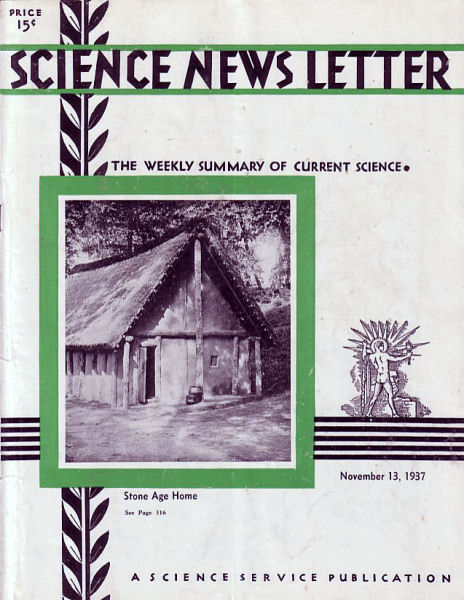From the November 13, 1937, issue

REBUILT EUROPEAN HOMES OF FORTY CENTURIES AGO
Houses in which our ancestors lived at the time of Christ, and 2,000 years before then, are shown restored in full size and original condition at a new open-air museum in the north German city of Luebeck.
They may be considered ancestral homes of Englishmen as well as of Continental Germanic-speaking peoples, for the tribes that colonized Britain and gave rise to what we call the Anglo-Saxon culture started from this part of the European mainland.
The two houses stand a little distance from each other in the park, each an exact restoration in architecture, building materials, and interior furnishings, according to the best information scientists have been able to obtain.
The restoration of the older of the two houses, showing a New Stone Age farmstead of about 2000 B.C., is a rectangular building with a steeply pitched roof of thatch. The ridgepole of the roof is supported on two stout upright posts and projects at either end.
RUNAWAY OBJECT BREAKS CELESTIAL SPEED LIMITS
A runaway of the skies, which may be a new comet but is more probably a small asteroid, has been detected speeding far faster than celestial bodies have any real business to go, by a well-known German comet hunter, K. Reinmuth of Heidelberg, and reported to the international clearinghouse for astronomical discoveries in Copenhagen.
The object, whatever it is, was moving at a velocity of 64 minutes of arc a day when last observed. This is an indication that it is fairly close to the Earth and is moving very fast. Its appearance through the telescope is reported as starlike. This lends support to the theory that it is an asteroid. Comets are usually rather diffuse and “fuzzy.”
When discovered, the object was near the constellation Pisces. At first of the tenth magnitude, it later brightened to the eighth.
‘SAFETY HEADLIGHT’ TILTS WHEN AUTO CLIMBS HILL
A safety automobile headlight that automatically tilts so as always to shine on the road, regardless of whether the automobile is climbing or descending or traveling along a level highway, has been patented by Paul Astorg, a Berkeley resident.
It is designed, its inventor states in the papers on which patent No. 2,096,777 was issued by the U.S. Patent Office in Washington, particularly to avert the situation of which all motorists have complained in the past. When an automobile equipped with standard lamps approaches the summit of a hill, its lights shine straight past the summit instead of on the road. The new type lamp, by pointing downward when the car is climbing, avoids this difficulty.
A standard headlamp is fitted into a special cylindrical mounting that allows it to swing to achieve the desired effect. The patent covers the mounting.







